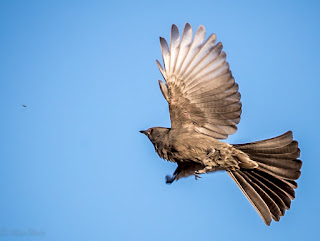In the United States, the Phainopepla is a southwestern bird. In Tucson, Arizona they're here year-round.
With a gleaming black body, erect crest and dramatic red eyes, they make you take notice whenever you see one.
The white wing markings are visible only in flight, so watch for that when they fly away.
This being spring, the Phainopepla are in a nest building frame of mind. Presenting material to the female in the tree above was this male's aim.
Not bad, huh?
Fine! Okay! I get it!
This piece is rejected.
Meanwhile, the female Phainopepla in the tree concentrates on food.
The early morning sun had warmed her pale tan body and, most importantly, the sun has the flying insects up and out of the grass.
This tree borders an abandoned golf course fairway. I assume the insects have returned in numbers because the insecticide applications have stopped.
She targets an insect (upper left corner) with an abrupt course correction. Insects are high in protein and are an important food resource for this spring's eventual baby Phainopepla.
(Click any picture to enlarge)
She swings right, then left, as the tiny flying insect (center left) tries to avoid being a snack.
This is a David and Goliath match-up.
Still the insect has maneuverability on its side, though it lacks speed and endurance.
With a swift 180 degree turn, the Phainopepla grabs the insect out of the air. It looks as if this battle is over and a tiny, tiny prize has been won.
But not so fast!
Something happens between this grab-it-'n-go, as the insect escapes.
I can't truly claim the insect got clean away as this was a dizzying chain of twists and turns. It matters little though.
There will be other insects and other birds. What's important is that this exchange continues to repeat in clean air and open space.
Allan
Credits: Cornell Lab of Ornithology, All About Birds
The Sibley Guide to Birds








No comments:
Post a Comment